HNB3123 Evidence Based Nursing: Critical Appraisal Essay
VerifiedAdded on 2023/06/12
|8
|2090
|140
Essay
AI Summary
This essay presents a critical appraisal of a research article focusing on the relationship between nurse staffing levels and nursing-sensitive outcomes in Korean tertiary hospitals. The appraisal examines the research problem, its significance, the retrospective observational study design, and the methods used, including multiple logistic regression to analyze nursing-sensitive outcomes. The findings reveal significant associations between nurse staffing levels and outcomes such as hospital-acquired pneumonia, urinary tract infections, and in-hospital deaths. The appraisal discusses the relevance of these findings to contemporary nursing policy and practice, emphasizing the importance of adequate nurse staffing for patient care quality and safety, and highlighting the implications for healthcare organizations and government policies. The conclusion underscores the importance of these results for improving nursing quality and informing patients about healthcare options in Korea.
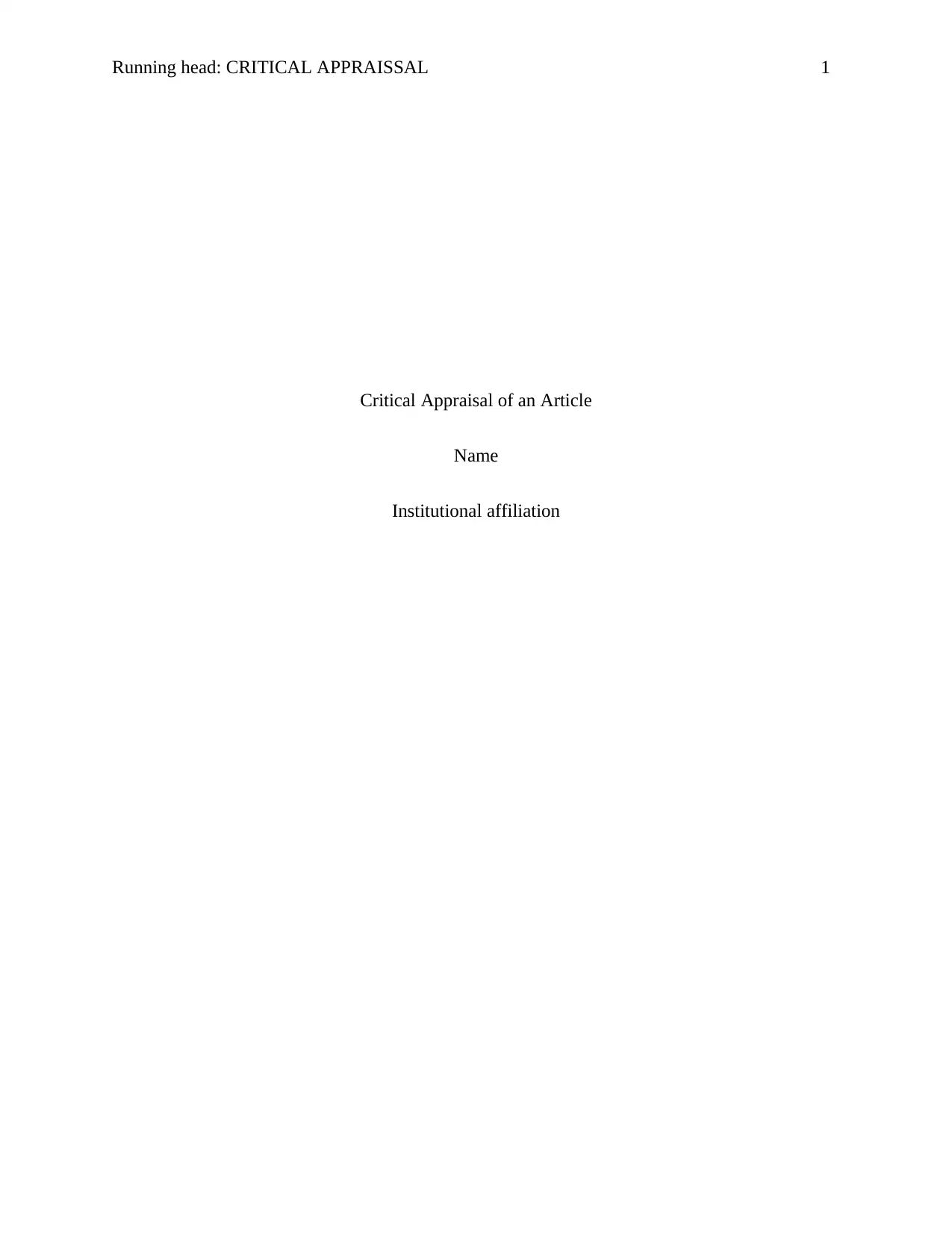
Running head: CRITICAL APPRAISSAL 1
Critical Appraisal of an Article
Name
Institutional affiliation
Critical Appraisal of an Article
Name
Institutional affiliation
Paraphrase This Document
Need a fresh take? Get an instant paraphrase of this document with our AI Paraphraser
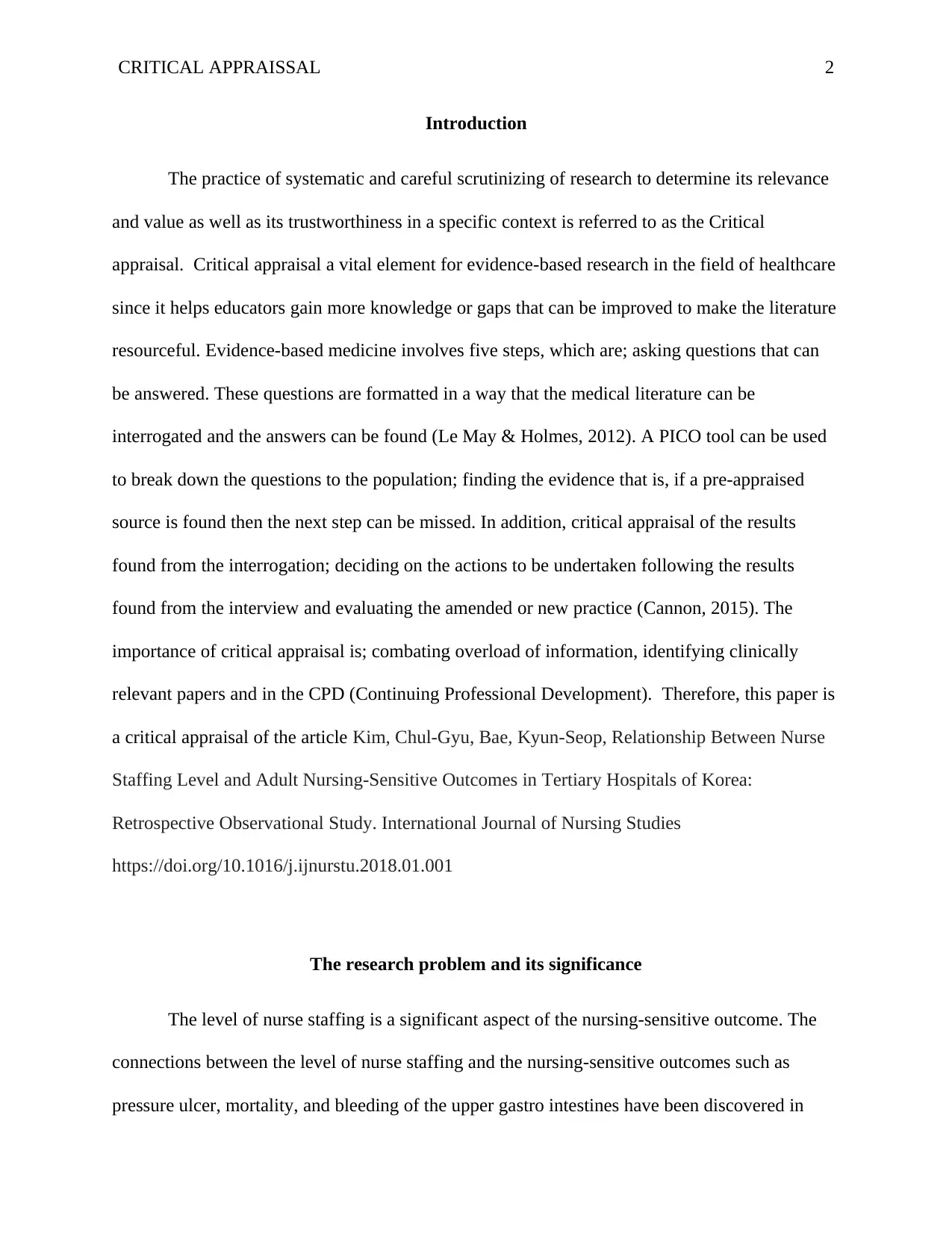
CRITICAL APPRAISSAL 2
Introduction
The practice of systematic and careful scrutinizing of research to determine its relevance
and value as well as its trustworthiness in a specific context is referred to as the Critical
appraisal. Critical appraisal a vital element for evidence-based research in the field of healthcare
since it helps educators gain more knowledge or gaps that can be improved to make the literature
resourceful. Evidence-based medicine involves five steps, which are; asking questions that can
be answered. These questions are formatted in a way that the medical literature can be
interrogated and the answers can be found (Le May & Holmes, 2012). A PICO tool can be used
to break down the questions to the population; finding the evidence that is, if a pre-appraised
source is found then the next step can be missed. In addition, critical appraisal of the results
found from the interrogation; deciding on the actions to be undertaken following the results
found from the interview and evaluating the amended or new practice (Cannon, 2015). The
importance of critical appraisal is; combating overload of information, identifying clinically
relevant papers and in the CPD (Continuing Professional Development). Therefore, this paper is
a critical appraisal of the article Kim, Chul-Gyu, Bae, Kyun-Seop, Relationship Between Nurse
Staffing Level and Adult Nursing-Sensitive Outcomes in Tertiary Hospitals of Korea:
Retrospective Observational Study. International Journal of Nursing Studies
https://doi.org/10.1016/j.ijnurstu.2018.01.001
The research problem and its significance
The level of nurse staffing is a significant aspect of the nursing-sensitive outcome. The
connections between the level of nurse staffing and the nursing-sensitive outcomes such as
pressure ulcer, mortality, and bleeding of the upper gastro intestines have been discovered in
Introduction
The practice of systematic and careful scrutinizing of research to determine its relevance
and value as well as its trustworthiness in a specific context is referred to as the Critical
appraisal. Critical appraisal a vital element for evidence-based research in the field of healthcare
since it helps educators gain more knowledge or gaps that can be improved to make the literature
resourceful. Evidence-based medicine involves five steps, which are; asking questions that can
be answered. These questions are formatted in a way that the medical literature can be
interrogated and the answers can be found (Le May & Holmes, 2012). A PICO tool can be used
to break down the questions to the population; finding the evidence that is, if a pre-appraised
source is found then the next step can be missed. In addition, critical appraisal of the results
found from the interrogation; deciding on the actions to be undertaken following the results
found from the interview and evaluating the amended or new practice (Cannon, 2015). The
importance of critical appraisal is; combating overload of information, identifying clinically
relevant papers and in the CPD (Continuing Professional Development). Therefore, this paper is
a critical appraisal of the article Kim, Chul-Gyu, Bae, Kyun-Seop, Relationship Between Nurse
Staffing Level and Adult Nursing-Sensitive Outcomes in Tertiary Hospitals of Korea:
Retrospective Observational Study. International Journal of Nursing Studies
https://doi.org/10.1016/j.ijnurstu.2018.01.001
The research problem and its significance
The level of nurse staffing is a significant aspect of the nursing-sensitive outcome. The
connections between the level of nurse staffing and the nursing-sensitive outcomes such as
pressure ulcer, mortality, and bleeding of the upper gastro intestines have been discovered in
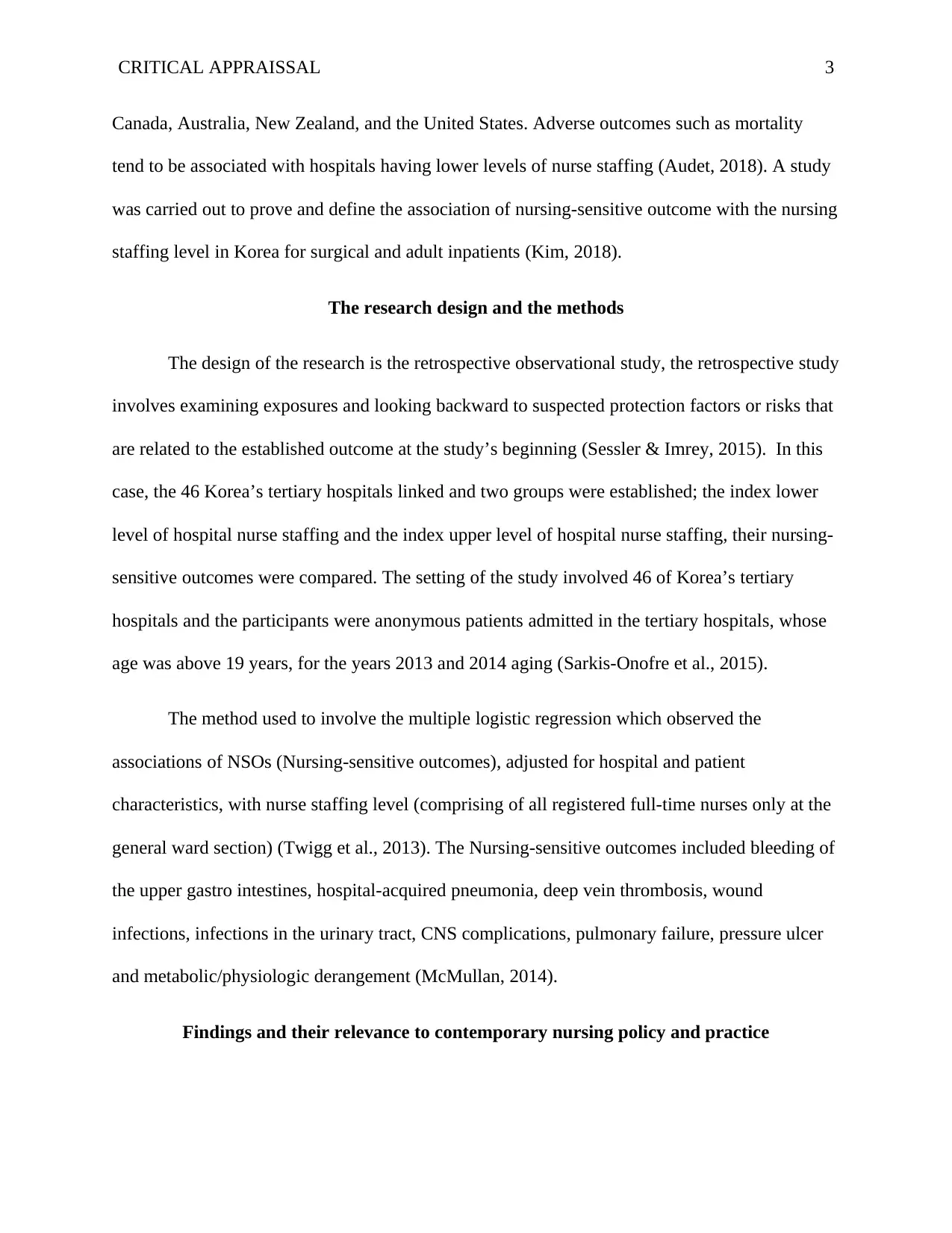
CRITICAL APPRAISSAL 3
Canada, Australia, New Zealand, and the United States. Adverse outcomes such as mortality
tend to be associated with hospitals having lower levels of nurse staffing (Audet, 2018). A study
was carried out to prove and define the association of nursing-sensitive outcome with the nursing
staffing level in Korea for surgical and adult inpatients (Kim, 2018).
The research design and the methods
The design of the research is the retrospective observational study, the retrospective study
involves examining exposures and looking backward to suspected protection factors or risks that
are related to the established outcome at the study’s beginning (Sessler & Imrey, 2015). In this
case, the 46 Korea’s tertiary hospitals linked and two groups were established; the index lower
level of hospital nurse staffing and the index upper level of hospital nurse staffing, their nursing-
sensitive outcomes were compared. The setting of the study involved 46 of Korea’s tertiary
hospitals and the participants were anonymous patients admitted in the tertiary hospitals, whose
age was above 19 years, for the years 2013 and 2014 aging (Sarkis-Onofre et al., 2015).
The method used to involve the multiple logistic regression which observed the
associations of NSOs (Nursing-sensitive outcomes), adjusted for hospital and patient
characteristics, with nurse staffing level (comprising of all registered full-time nurses only at the
general ward section) (Twigg et al., 2013). The Nursing-sensitive outcomes included bleeding of
the upper gastro intestines, hospital-acquired pneumonia, deep vein thrombosis, wound
infections, infections in the urinary tract, CNS complications, pulmonary failure, pressure ulcer
and metabolic/physiologic derangement (McMullan, 2014).
Findings and their relevance to contemporary nursing policy and practice
Canada, Australia, New Zealand, and the United States. Adverse outcomes such as mortality
tend to be associated with hospitals having lower levels of nurse staffing (Audet, 2018). A study
was carried out to prove and define the association of nursing-sensitive outcome with the nursing
staffing level in Korea for surgical and adult inpatients (Kim, 2018).
The research design and the methods
The design of the research is the retrospective observational study, the retrospective study
involves examining exposures and looking backward to suspected protection factors or risks that
are related to the established outcome at the study’s beginning (Sessler & Imrey, 2015). In this
case, the 46 Korea’s tertiary hospitals linked and two groups were established; the index lower
level of hospital nurse staffing and the index upper level of hospital nurse staffing, their nursing-
sensitive outcomes were compared. The setting of the study involved 46 of Korea’s tertiary
hospitals and the participants were anonymous patients admitted in the tertiary hospitals, whose
age was above 19 years, for the years 2013 and 2014 aging (Sarkis-Onofre et al., 2015).
The method used to involve the multiple logistic regression which observed the
associations of NSOs (Nursing-sensitive outcomes), adjusted for hospital and patient
characteristics, with nurse staffing level (comprising of all registered full-time nurses only at the
general ward section) (Twigg et al., 2013). The Nursing-sensitive outcomes included bleeding of
the upper gastro intestines, hospital-acquired pneumonia, deep vein thrombosis, wound
infections, infections in the urinary tract, CNS complications, pulmonary failure, pressure ulcer
and metabolic/physiologic derangement (McMullan, 2014).
Findings and their relevance to contemporary nursing policy and practice
⊘ This is a preview!⊘
Do you want full access?
Subscribe today to unlock all pages.

Trusted by 1+ million students worldwide
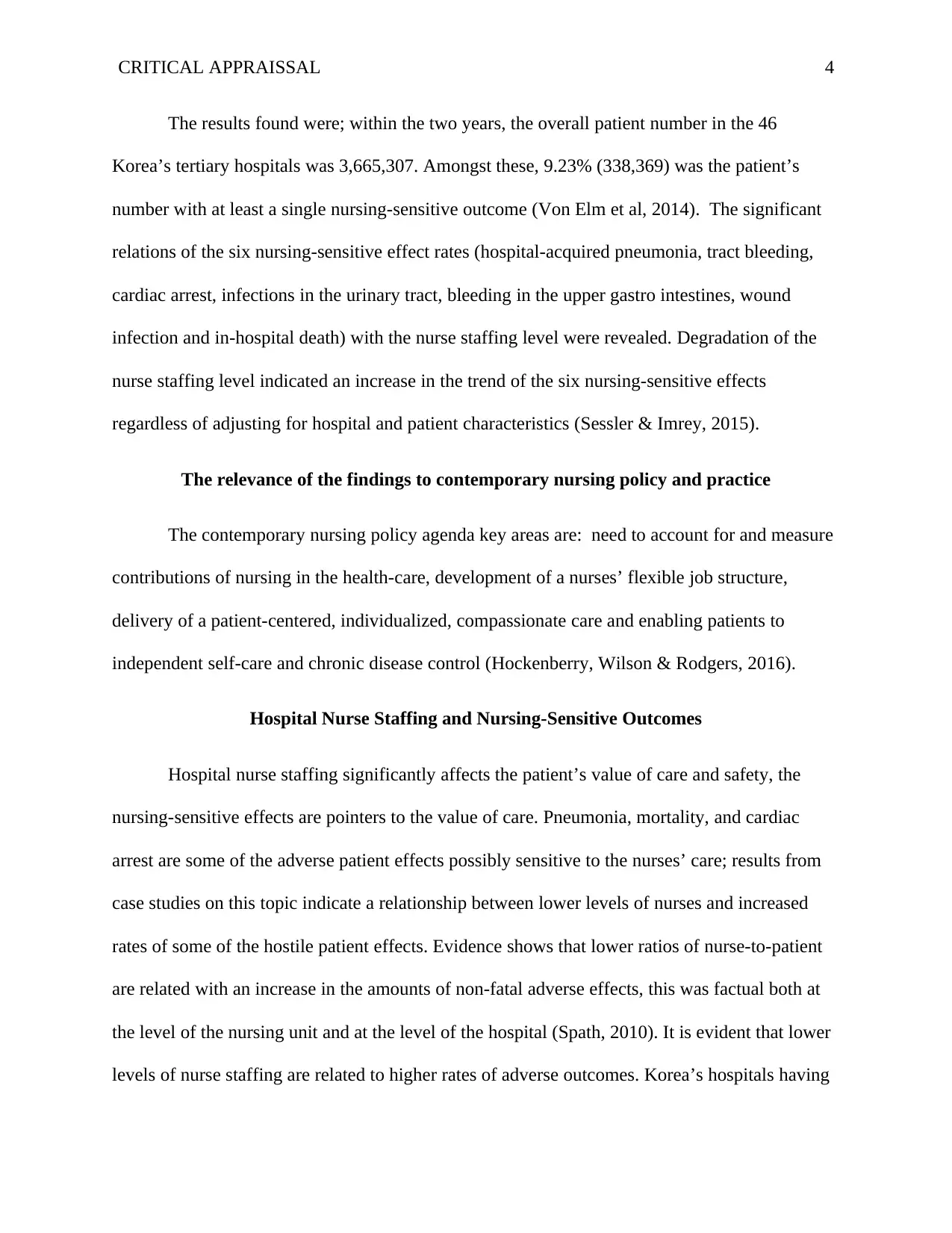
CRITICAL APPRAISSAL 4
The results found were; within the two years, the overall patient number in the 46
Korea’s tertiary hospitals was 3,665,307. Amongst these, 9.23% (338,369) was the patient’s
number with at least a single nursing-sensitive outcome (Von Elm et al, 2014). The significant
relations of the six nursing-sensitive effect rates (hospital-acquired pneumonia, tract bleeding,
cardiac arrest, infections in the urinary tract, bleeding in the upper gastro intestines, wound
infection and in-hospital death) with the nurse staffing level were revealed. Degradation of the
nurse staffing level indicated an increase in the trend of the six nursing-sensitive effects
regardless of adjusting for hospital and patient characteristics (Sessler & Imrey, 2015).
The relevance of the findings to contemporary nursing policy and practice
The contemporary nursing policy agenda key areas are: need to account for and measure
contributions of nursing in the health-care, development of a nurses’ flexible job structure,
delivery of a patient-centered, individualized, compassionate care and enabling patients to
independent self-care and chronic disease control (Hockenberry, Wilson & Rodgers, 2016).
Hospital Nurse Staffing and Nursing-Sensitive Outcomes
Hospital nurse staffing significantly affects the patient’s value of care and safety, the
nursing-sensitive effects are pointers to the value of care. Pneumonia, mortality, and cardiac
arrest are some of the adverse patient effects possibly sensitive to the nurses’ care; results from
case studies on this topic indicate a relationship between lower levels of nurses and increased
rates of some of the hostile patient effects. Evidence shows that lower ratios of nurse-to-patient
are related with an increase in the amounts of non-fatal adverse effects, this was factual both at
the level of the nursing unit and at the level of the hospital (Spath, 2010). It is evident that lower
levels of nurse staffing are related to higher rates of adverse outcomes. Korea’s hospitals having
The results found were; within the two years, the overall patient number in the 46
Korea’s tertiary hospitals was 3,665,307. Amongst these, 9.23% (338,369) was the patient’s
number with at least a single nursing-sensitive outcome (Von Elm et al, 2014). The significant
relations of the six nursing-sensitive effect rates (hospital-acquired pneumonia, tract bleeding,
cardiac arrest, infections in the urinary tract, bleeding in the upper gastro intestines, wound
infection and in-hospital death) with the nurse staffing level were revealed. Degradation of the
nurse staffing level indicated an increase in the trend of the six nursing-sensitive effects
regardless of adjusting for hospital and patient characteristics (Sessler & Imrey, 2015).
The relevance of the findings to contemporary nursing policy and practice
The contemporary nursing policy agenda key areas are: need to account for and measure
contributions of nursing in the health-care, development of a nurses’ flexible job structure,
delivery of a patient-centered, individualized, compassionate care and enabling patients to
independent self-care and chronic disease control (Hockenberry, Wilson & Rodgers, 2016).
Hospital Nurse Staffing and Nursing-Sensitive Outcomes
Hospital nurse staffing significantly affects the patient’s value of care and safety, the
nursing-sensitive effects are pointers to the value of care. Pneumonia, mortality, and cardiac
arrest are some of the adverse patient effects possibly sensitive to the nurses’ care; results from
case studies on this topic indicate a relationship between lower levels of nurses and increased
rates of some of the hostile patient effects. Evidence shows that lower ratios of nurse-to-patient
are related with an increase in the amounts of non-fatal adverse effects, this was factual both at
the level of the nursing unit and at the level of the hospital (Spath, 2010). It is evident that lower
levels of nurse staffing are related to higher rates of adverse outcomes. Korea’s hospitals having
Paraphrase This Document
Need a fresh take? Get an instant paraphrase of this document with our AI Paraphraser
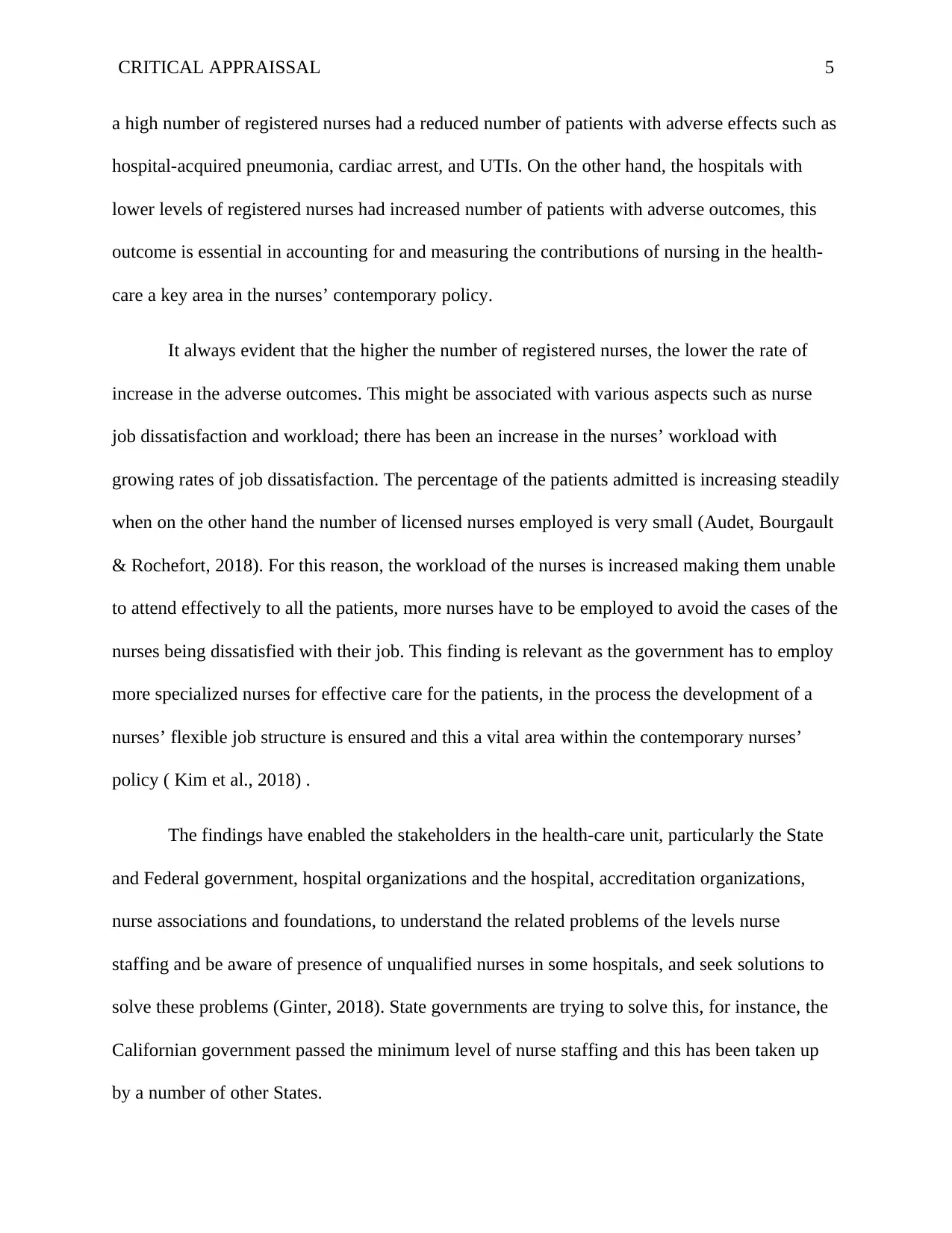
CRITICAL APPRAISSAL 5
a high number of registered nurses had a reduced number of patients with adverse effects such as
hospital-acquired pneumonia, cardiac arrest, and UTIs. On the other hand, the hospitals with
lower levels of registered nurses had increased number of patients with adverse outcomes, this
outcome is essential in accounting for and measuring the contributions of nursing in the health-
care a key area in the nurses’ contemporary policy.
It always evident that the higher the number of registered nurses, the lower the rate of
increase in the adverse outcomes. This might be associated with various aspects such as nurse
job dissatisfaction and workload; there has been an increase in the nurses’ workload with
growing rates of job dissatisfaction. The percentage of the patients admitted is increasing steadily
when on the other hand the number of licensed nurses employed is very small (Audet, Bourgault
& Rochefort, 2018). For this reason, the workload of the nurses is increased making them unable
to attend effectively to all the patients, more nurses have to be employed to avoid the cases of the
nurses being dissatisfied with their job. This finding is relevant as the government has to employ
more specialized nurses for effective care for the patients, in the process the development of a
nurses’ flexible job structure is ensured and this a vital area within the contemporary nurses’
policy ( Kim et al., 2018) .
The findings have enabled the stakeholders in the health-care unit, particularly the State
and Federal government, hospital organizations and the hospital, accreditation organizations,
nurse associations and foundations, to understand the related problems of the levels nurse
staffing and be aware of presence of unqualified nurses in some hospitals, and seek solutions to
solve these problems (Ginter, 2018). State governments are trying to solve this, for instance, the
Californian government passed the minimum level of nurse staffing and this has been taken up
by a number of other States.
a high number of registered nurses had a reduced number of patients with adverse effects such as
hospital-acquired pneumonia, cardiac arrest, and UTIs. On the other hand, the hospitals with
lower levels of registered nurses had increased number of patients with adverse outcomes, this
outcome is essential in accounting for and measuring the contributions of nursing in the health-
care a key area in the nurses’ contemporary policy.
It always evident that the higher the number of registered nurses, the lower the rate of
increase in the adverse outcomes. This might be associated with various aspects such as nurse
job dissatisfaction and workload; there has been an increase in the nurses’ workload with
growing rates of job dissatisfaction. The percentage of the patients admitted is increasing steadily
when on the other hand the number of licensed nurses employed is very small (Audet, Bourgault
& Rochefort, 2018). For this reason, the workload of the nurses is increased making them unable
to attend effectively to all the patients, more nurses have to be employed to avoid the cases of the
nurses being dissatisfied with their job. This finding is relevant as the government has to employ
more specialized nurses for effective care for the patients, in the process the development of a
nurses’ flexible job structure is ensured and this a vital area within the contemporary nurses’
policy ( Kim et al., 2018) .
The findings have enabled the stakeholders in the health-care unit, particularly the State
and Federal government, hospital organizations and the hospital, accreditation organizations,
nurse associations and foundations, to understand the related problems of the levels nurse
staffing and be aware of presence of unqualified nurses in some hospitals, and seek solutions to
solve these problems (Ginter, 2018). State governments are trying to solve this, for instance, the
Californian government passed the minimum level of nurse staffing and this has been taken up
by a number of other States.
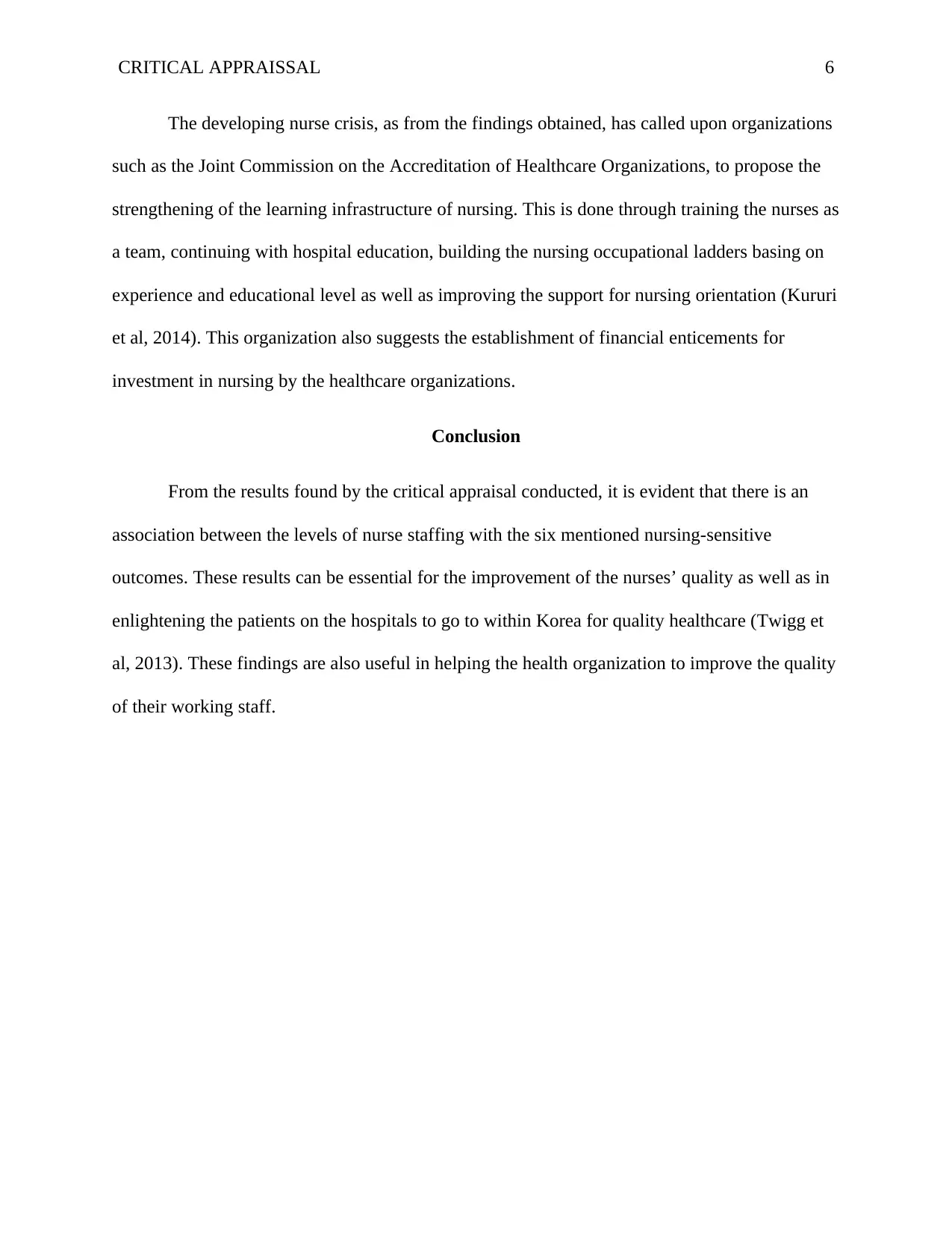
CRITICAL APPRAISSAL 6
The developing nurse crisis, as from the findings obtained, has called upon organizations
such as the Joint Commission on the Accreditation of Healthcare Organizations, to propose the
strengthening of the learning infrastructure of nursing. This is done through training the nurses as
a team, continuing with hospital education, building the nursing occupational ladders basing on
experience and educational level as well as improving the support for nursing orientation (Kururi
et al, 2014). This organization also suggests the establishment of financial enticements for
investment in nursing by the healthcare organizations.
Conclusion
From the results found by the critical appraisal conducted, it is evident that there is an
association between the levels of nurse staffing with the six mentioned nursing-sensitive
outcomes. These results can be essential for the improvement of the nurses’ quality as well as in
enlightening the patients on the hospitals to go to within Korea for quality healthcare (Twigg et
al, 2013). These findings are also useful in helping the health organization to improve the quality
of their working staff.
The developing nurse crisis, as from the findings obtained, has called upon organizations
such as the Joint Commission on the Accreditation of Healthcare Organizations, to propose the
strengthening of the learning infrastructure of nursing. This is done through training the nurses as
a team, continuing with hospital education, building the nursing occupational ladders basing on
experience and educational level as well as improving the support for nursing orientation (Kururi
et al, 2014). This organization also suggests the establishment of financial enticements for
investment in nursing by the healthcare organizations.
Conclusion
From the results found by the critical appraisal conducted, it is evident that there is an
association between the levels of nurse staffing with the six mentioned nursing-sensitive
outcomes. These results can be essential for the improvement of the nurses’ quality as well as in
enlightening the patients on the hospitals to go to within Korea for quality healthcare (Twigg et
al, 2013). These findings are also useful in helping the health organization to improve the quality
of their working staff.
⊘ This is a preview!⊘
Do you want full access?
Subscribe today to unlock all pages.

Trusted by 1+ million students worldwide
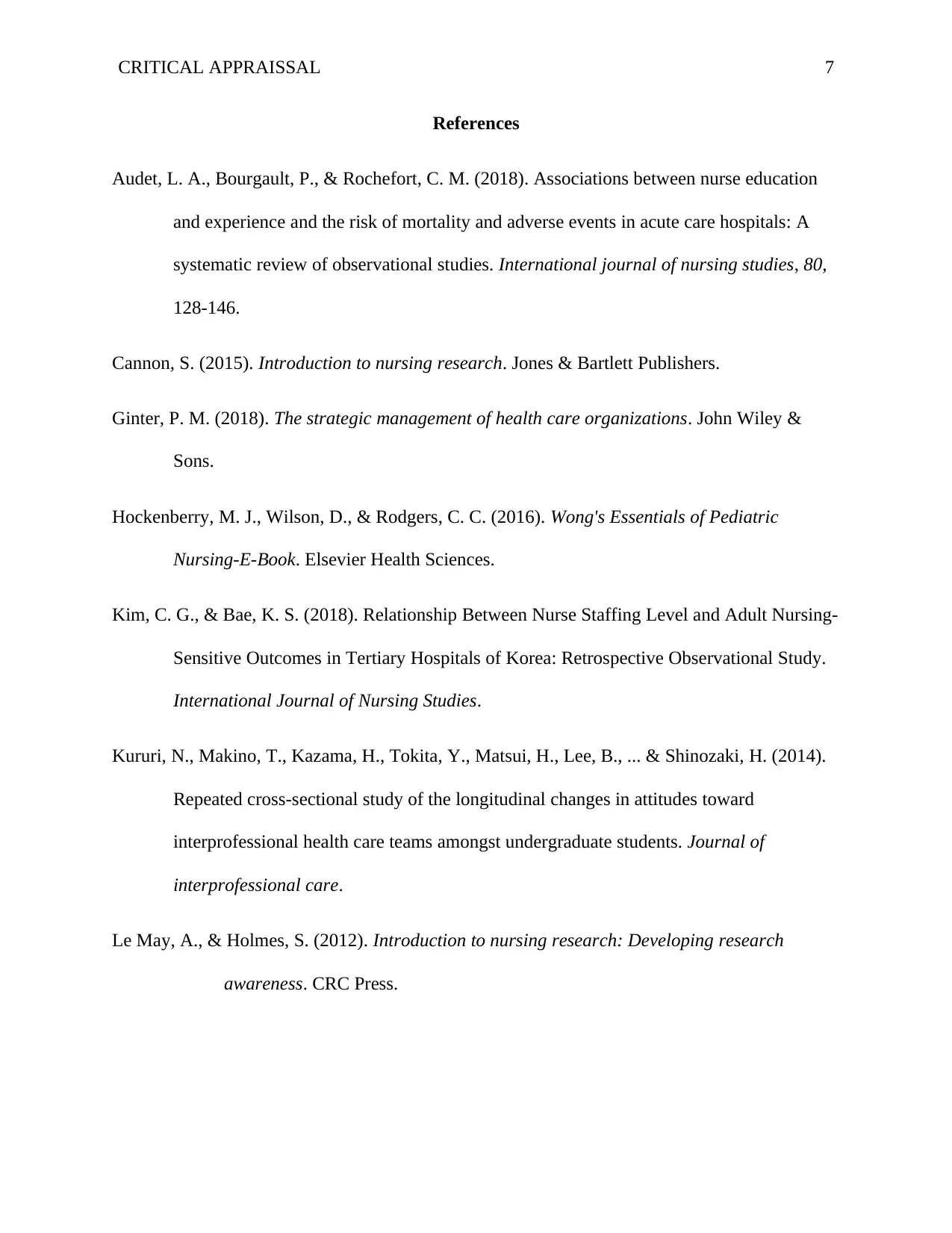
CRITICAL APPRAISSAL 7
References
Audet, L. A., Bourgault, P., & Rochefort, C. M. (2018). Associations between nurse education
and experience and the risk of mortality and adverse events in acute care hospitals: A
systematic review of observational studies. International journal of nursing studies, 80,
128-146.
Cannon, S. (2015). Introduction to nursing research. Jones & Bartlett Publishers.
Ginter, P. M. (2018). The strategic management of health care organizations. John Wiley &
Sons.
Hockenberry, M. J., Wilson, D., & Rodgers, C. C. (2016). Wong's Essentials of Pediatric
Nursing-E-Book. Elsevier Health Sciences.
Kim, C. G., & Bae, K. S. (2018). Relationship Between Nurse Staffing Level and Adult Nursing-
Sensitive Outcomes in Tertiary Hospitals of Korea: Retrospective Observational Study.
International Journal of Nursing Studies.
Kururi, N., Makino, T., Kazama, H., Tokita, Y., Matsui, H., Lee, B., ... & Shinozaki, H. (2014).
Repeated cross-sectional study of the longitudinal changes in attitudes toward
interprofessional health care teams amongst undergraduate students. Journal of
interprofessional care.
Le May, A., & Holmes, S. (2012). Introduction to nursing research: Developing research
awareness. CRC Press.
References
Audet, L. A., Bourgault, P., & Rochefort, C. M. (2018). Associations between nurse education
and experience and the risk of mortality and adverse events in acute care hospitals: A
systematic review of observational studies. International journal of nursing studies, 80,
128-146.
Cannon, S. (2015). Introduction to nursing research. Jones & Bartlett Publishers.
Ginter, P. M. (2018). The strategic management of health care organizations. John Wiley &
Sons.
Hockenberry, M. J., Wilson, D., & Rodgers, C. C. (2016). Wong's Essentials of Pediatric
Nursing-E-Book. Elsevier Health Sciences.
Kim, C. G., & Bae, K. S. (2018). Relationship Between Nurse Staffing Level and Adult Nursing-
Sensitive Outcomes in Tertiary Hospitals of Korea: Retrospective Observational Study.
International Journal of Nursing Studies.
Kururi, N., Makino, T., Kazama, H., Tokita, Y., Matsui, H., Lee, B., ... & Shinozaki, H. (2014).
Repeated cross-sectional study of the longitudinal changes in attitudes toward
interprofessional health care teams amongst undergraduate students. Journal of
interprofessional care.
Le May, A., & Holmes, S. (2012). Introduction to nursing research: Developing research
awareness. CRC Press.
Paraphrase This Document
Need a fresh take? Get an instant paraphrase of this document with our AI Paraphraser
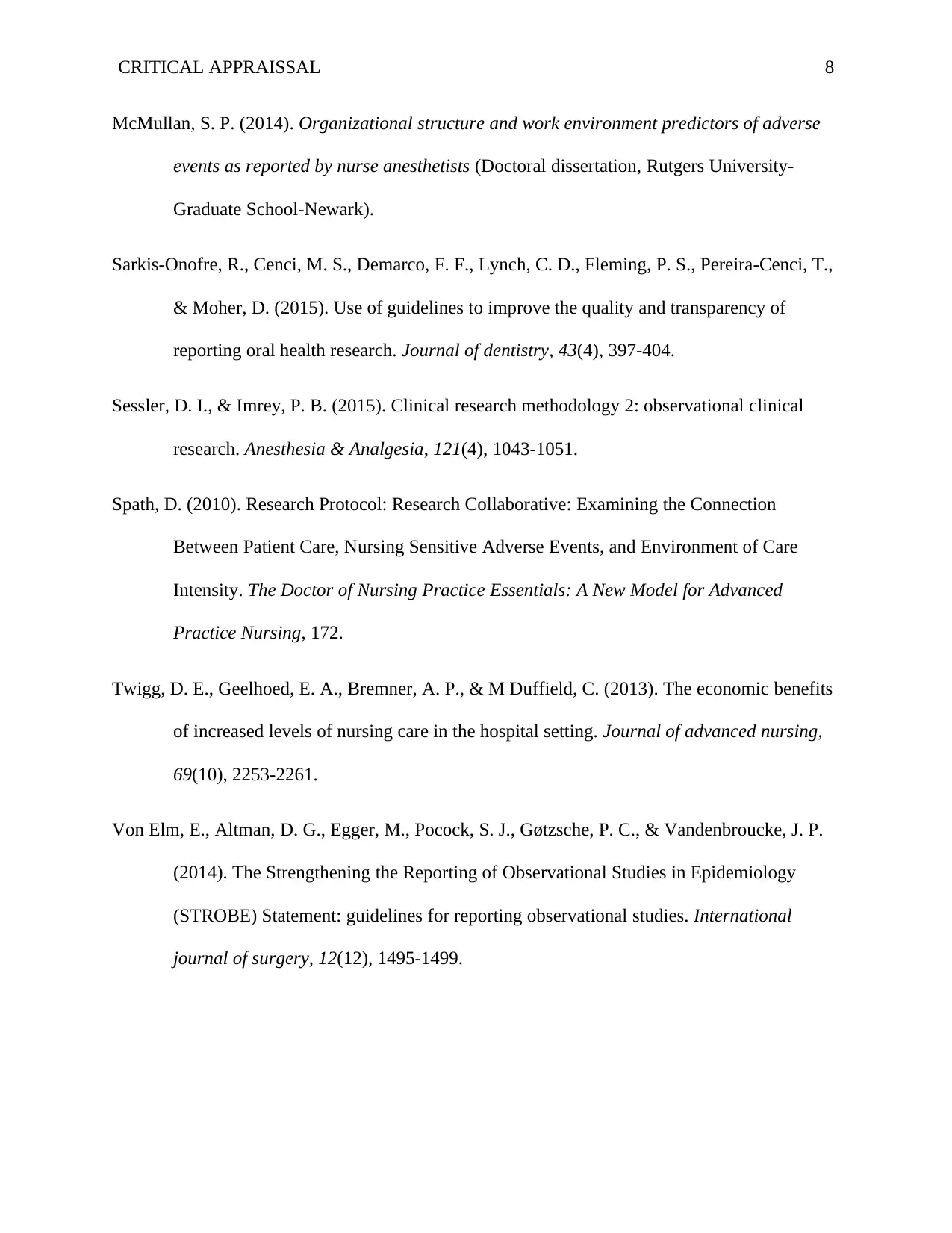
CRITICAL APPRAISSAL 8
McMullan, S. P. (2014). Organizational structure and work environment predictors of adverse
events as reported by nurse anesthetists (Doctoral dissertation, Rutgers University-
Graduate School-Newark).
Sarkis-Onofre, R., Cenci, M. S., Demarco, F. F., Lynch, C. D., Fleming, P. S., Pereira-Cenci, T.,
& Moher, D. (2015). Use of guidelines to improve the quality and transparency of
reporting oral health research. Journal of dentistry, 43(4), 397-404.
Sessler, D. I., & Imrey, P. B. (2015). Clinical research methodology 2: observational clinical
research. Anesthesia & Analgesia, 121(4), 1043-1051.
Spath, D. (2010). Research Protocol: Research Collaborative: Examining the Connection
Between Patient Care, Nursing Sensitive Adverse Events, and Environment of Care
Intensity. The Doctor of Nursing Practice Essentials: A New Model for Advanced
Practice Nursing, 172.
Twigg, D. E., Geelhoed, E. A., Bremner, A. P., & M Duffield, C. (2013). The economic benefits
of increased levels of nursing care in the hospital setting. Journal of advanced nursing,
69(10), 2253-2261.
Von Elm, E., Altman, D. G., Egger, M., Pocock, S. J., Gøtzsche, P. C., & Vandenbroucke, J. P.
(2014). The Strengthening the Reporting of Observational Studies in Epidemiology
(STROBE) Statement: guidelines for reporting observational studies. International
journal of surgery, 12(12), 1495-1499.
McMullan, S. P. (2014). Organizational structure and work environment predictors of adverse
events as reported by nurse anesthetists (Doctoral dissertation, Rutgers University-
Graduate School-Newark).
Sarkis-Onofre, R., Cenci, M. S., Demarco, F. F., Lynch, C. D., Fleming, P. S., Pereira-Cenci, T.,
& Moher, D. (2015). Use of guidelines to improve the quality and transparency of
reporting oral health research. Journal of dentistry, 43(4), 397-404.
Sessler, D. I., & Imrey, P. B. (2015). Clinical research methodology 2: observational clinical
research. Anesthesia & Analgesia, 121(4), 1043-1051.
Spath, D. (2010). Research Protocol: Research Collaborative: Examining the Connection
Between Patient Care, Nursing Sensitive Adverse Events, and Environment of Care
Intensity. The Doctor of Nursing Practice Essentials: A New Model for Advanced
Practice Nursing, 172.
Twigg, D. E., Geelhoed, E. A., Bremner, A. P., & M Duffield, C. (2013). The economic benefits
of increased levels of nursing care in the hospital setting. Journal of advanced nursing,
69(10), 2253-2261.
Von Elm, E., Altman, D. G., Egger, M., Pocock, S. J., Gøtzsche, P. C., & Vandenbroucke, J. P.
(2014). The Strengthening the Reporting of Observational Studies in Epidemiology
(STROBE) Statement: guidelines for reporting observational studies. International
journal of surgery, 12(12), 1495-1499.
1 out of 8
Related Documents
Your All-in-One AI-Powered Toolkit for Academic Success.
+13062052269
info@desklib.com
Available 24*7 on WhatsApp / Email
![[object Object]](/_next/static/media/star-bottom.7253800d.svg)
Unlock your academic potential
Copyright © 2020–2025 A2Z Services. All Rights Reserved. Developed and managed by ZUCOL.





